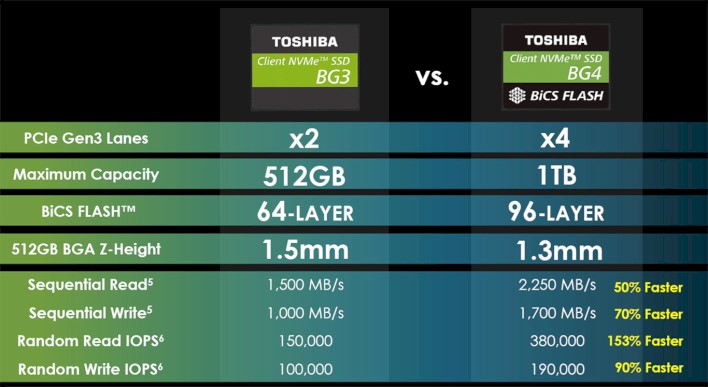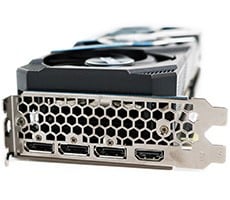Toshiba BG4 NVMe SSD Review: Minuscule But Mighty Storage
The 1TB Toshiba BG4 we will be showing you here is essentially a single-chip solution, cable of multi-gigabyte per second sequential transfers. It’s exactly the kind of device OEMs and ODMs look for when designing flagship, thin and light laptops and other devices, where performance is important, but available real estate is at a premium. When you need to cram a fast processor, gobs of RAM, and a battery large enough to provide a meaningful amount of untethered up-time into a razor thing chassis, every square millimeter counts.
|
The Toshiba BG4 improves upon its previous-generation BG3 in a number of ways. This new drive offers a full x4 PCI Express connection, to remove any bandwidth constraints from the interface. The BG4 will also be offered in capacities up to 1TB, which is double that of Toshiba's previous gen BG3. The BG4's Z-Height has been reduced slightly, but performance has been goosed-up quite a bit as well. Whereas the previous-gen BG3 topped out with 1.5GB/s and 1GB/s read and writes, respectively, the BG4 can hit over 2.2GB/s and 1.7GB/s. Peak IOPs have been increased as well. And although it’s not listed in the table, Toshiba is claiming an approximate 20% decrease in power. The previous generation BG3 could consume up to 0.97mW/MB/s, the BG4 uses only up to 0.78mW/MB/s.
Drives will be offered in capacities ranging from 128GB to 1TB in two different form factors. The drive you see here conforms to the M.2 2230 spec (the 1TB drive is M.2 2230-S3 specifically, the smaller capacities are M.2 2230-S2, which are slightly thinner – 1.5mm vs. 1.35mm), but they will also be offered in a single-chip BGA package which can be soldered down right on a motherboard. The M.2 2230 drives are comprised of little more than a basic PCB to make the necessary connections to an M.2 slot, plus some surface mounted components to filter power. In comparison to the Intel SSD 760P above, which leverages the common M.2 2280 form factor, you can see just how small the BG4 really is.
As for what’s inside that chip, Toshiba doesn’t disclose much about its controllers, but the BG4 packs 96-layer TLC BiCS flash memory, an NVMe 1.3b compliant controller with a native PCIe Gen 3 interface, and all of the necessary firmware in there. The drive also supports self-encryption with full support for Opal 2.01. It is also a DRAM-less solution, which leverages the Host Memory Buffer (HMB) feature to achieve its rated performance without the need for any DRAM. That helps keep power and the bill of materials down, but also limits peak performance.
And speaking of performance, benchmarks are up next...







